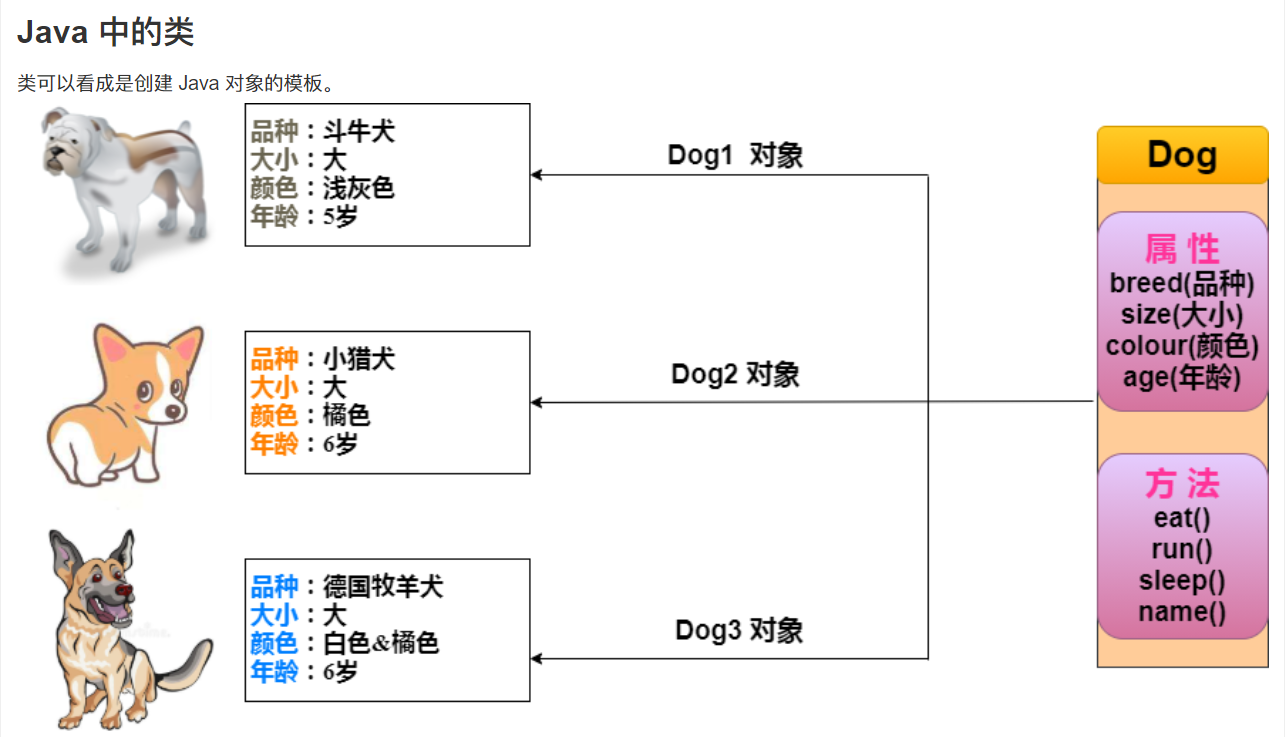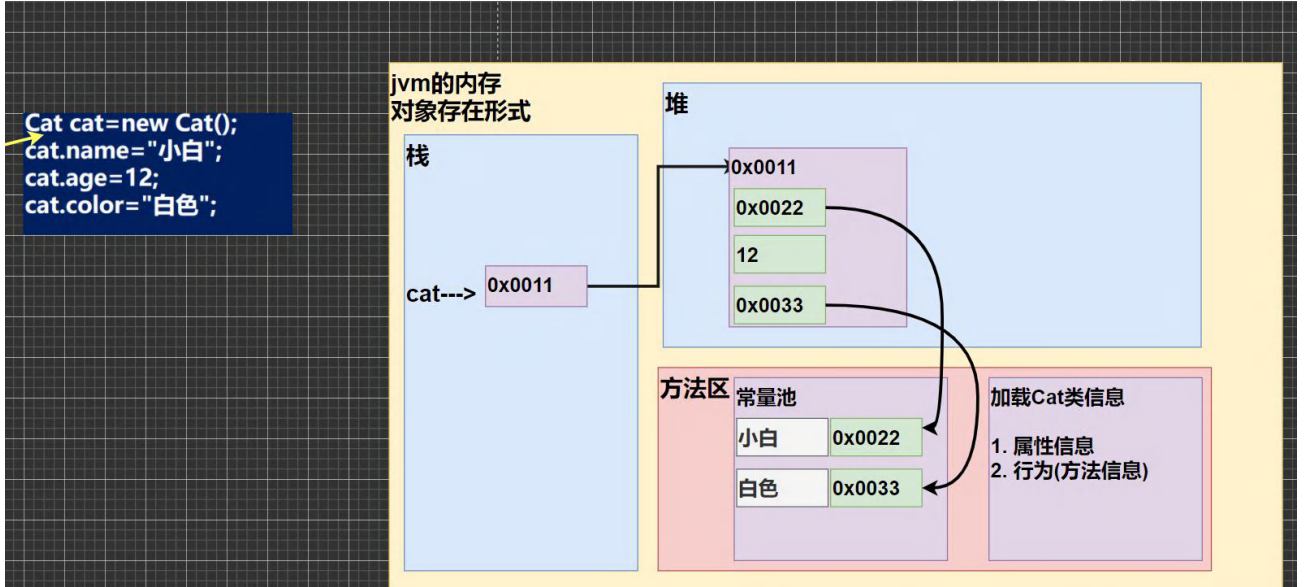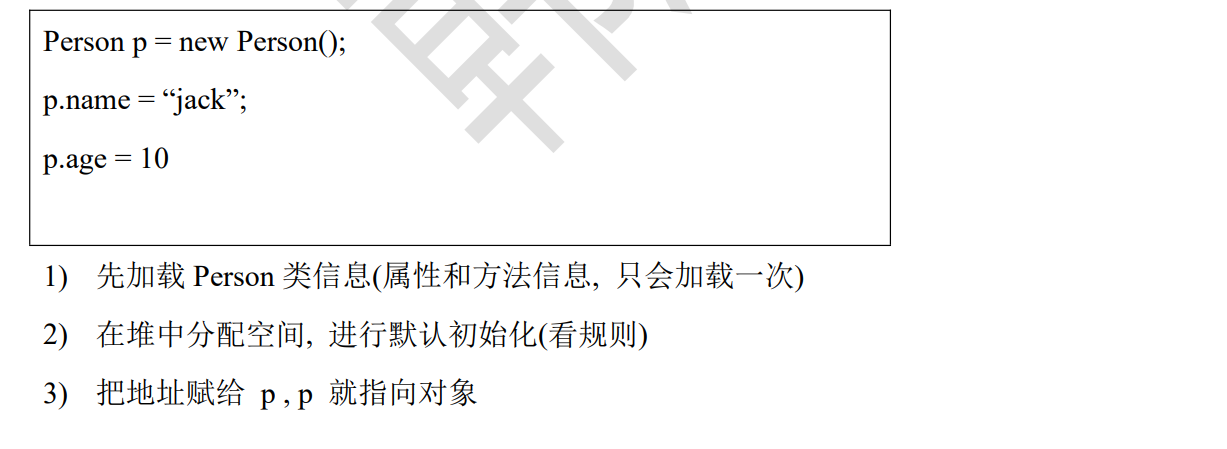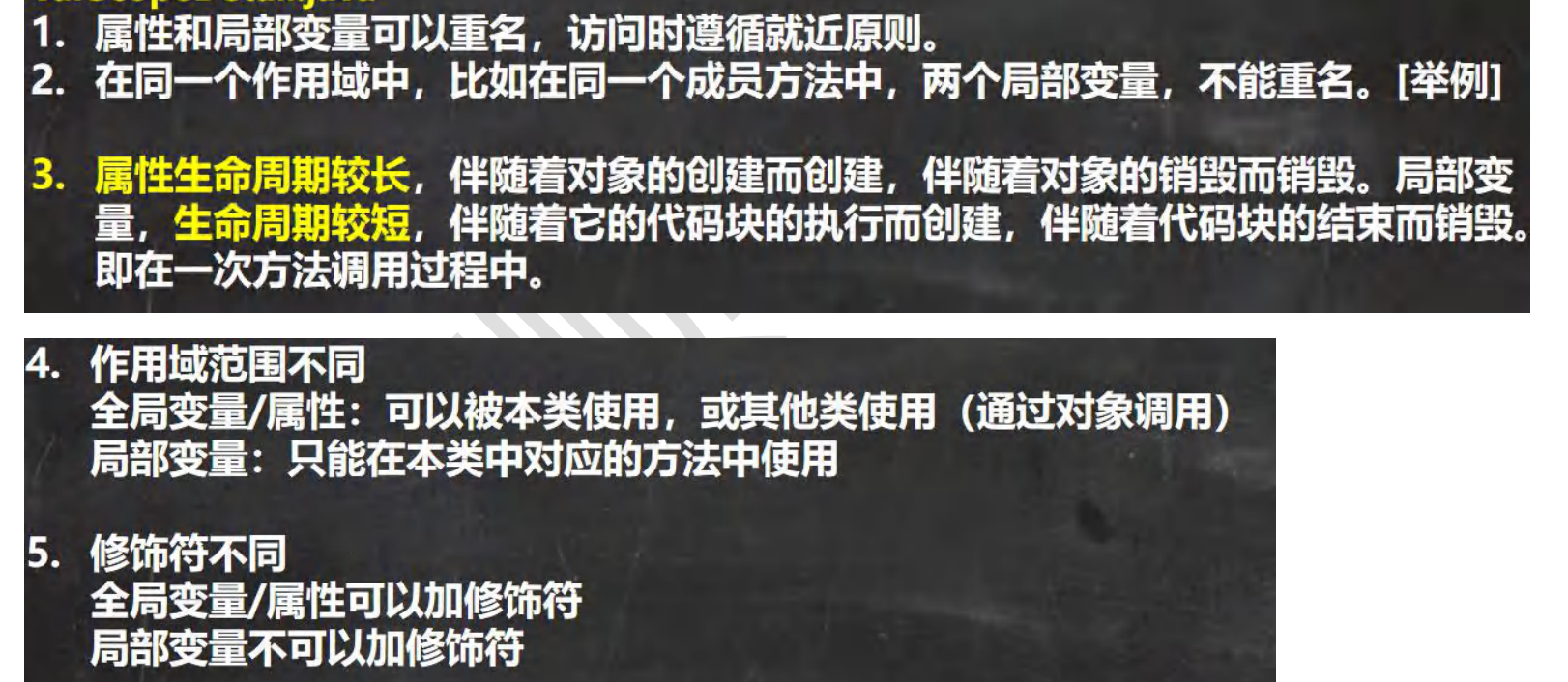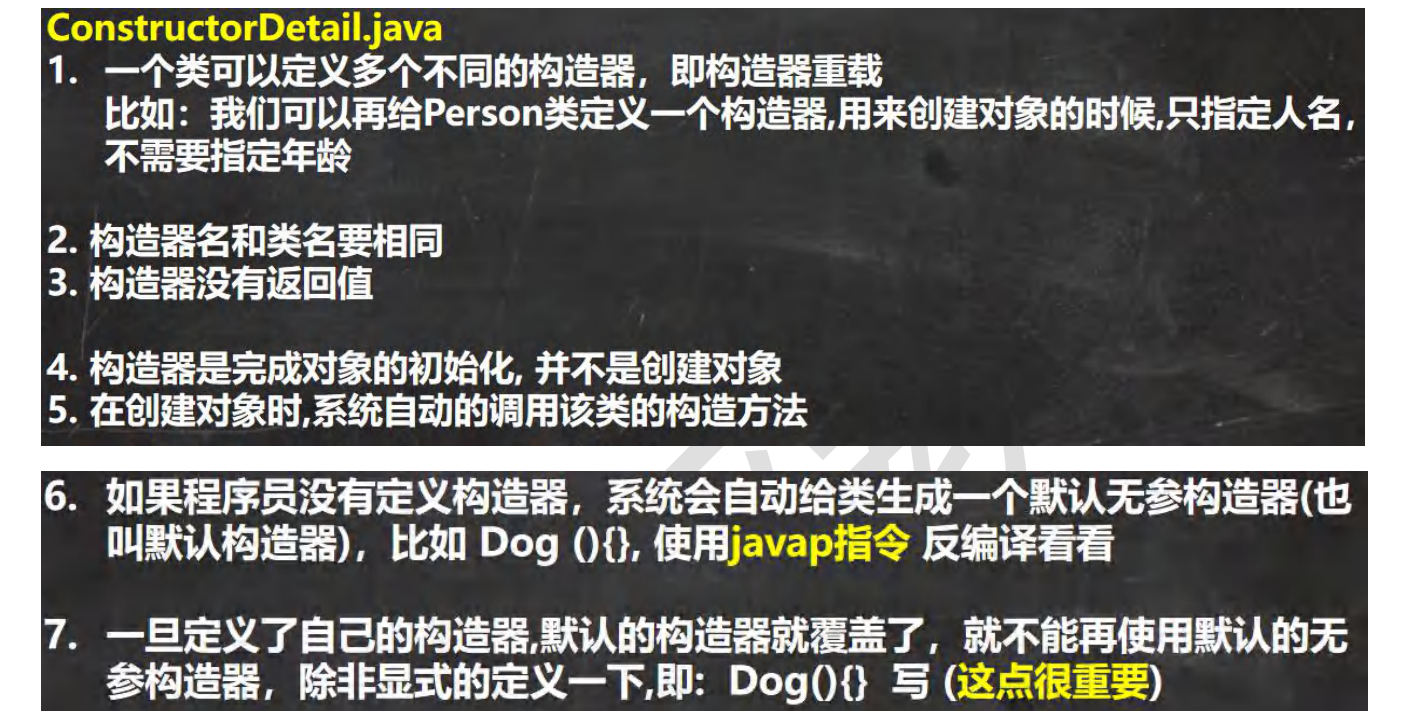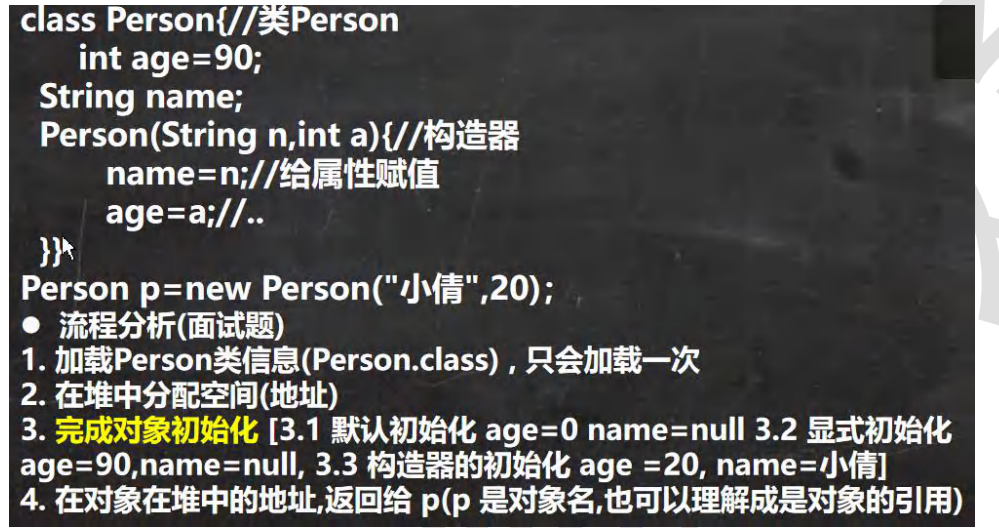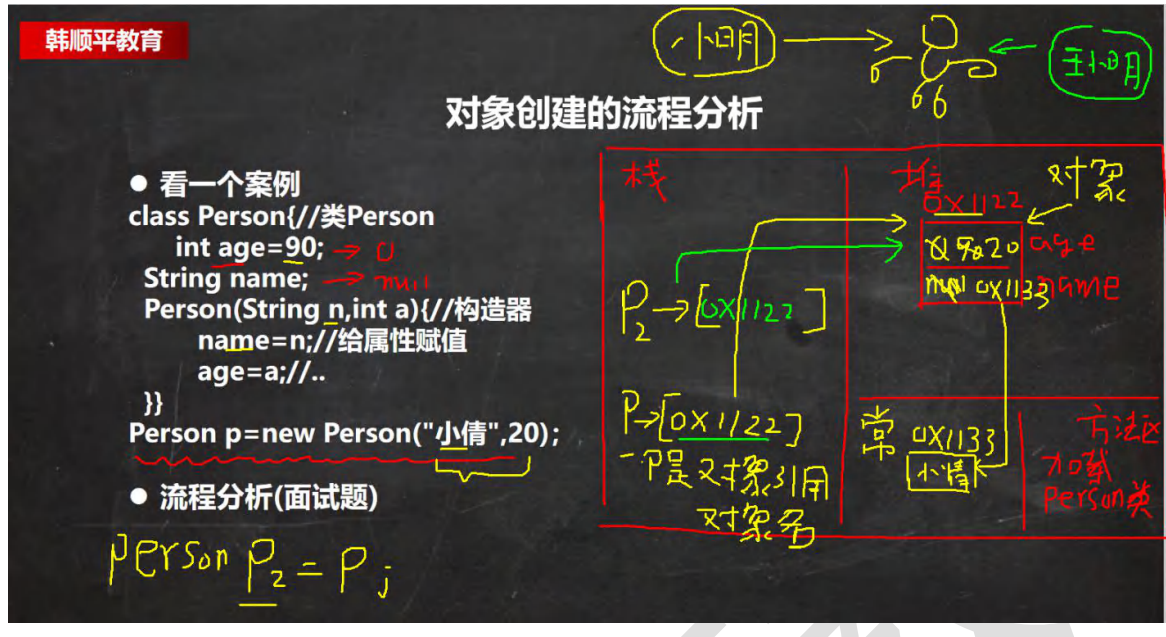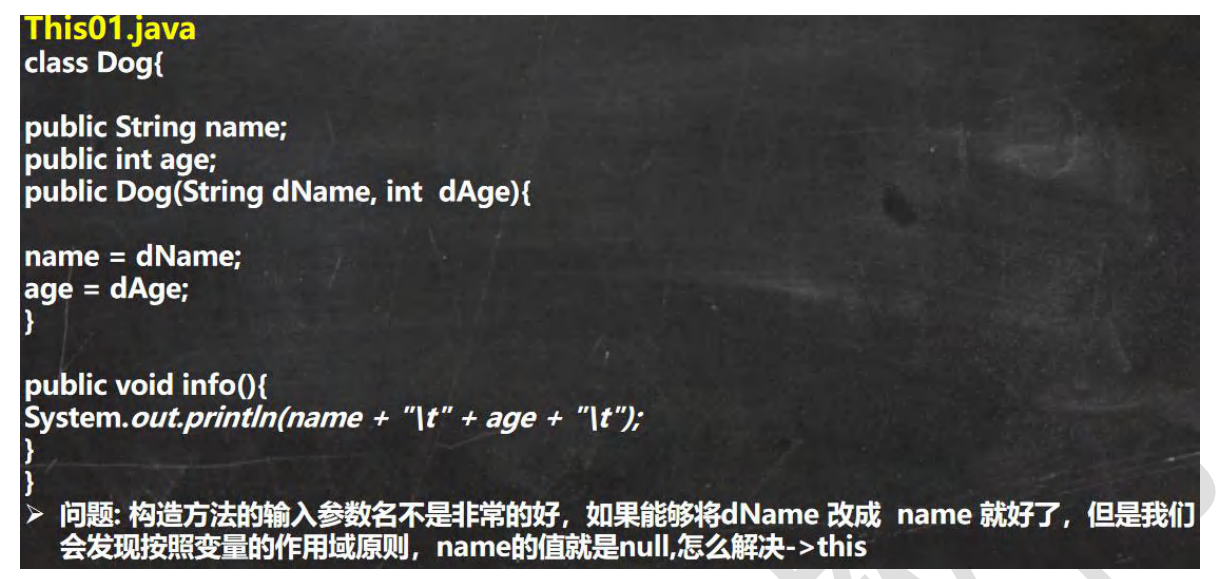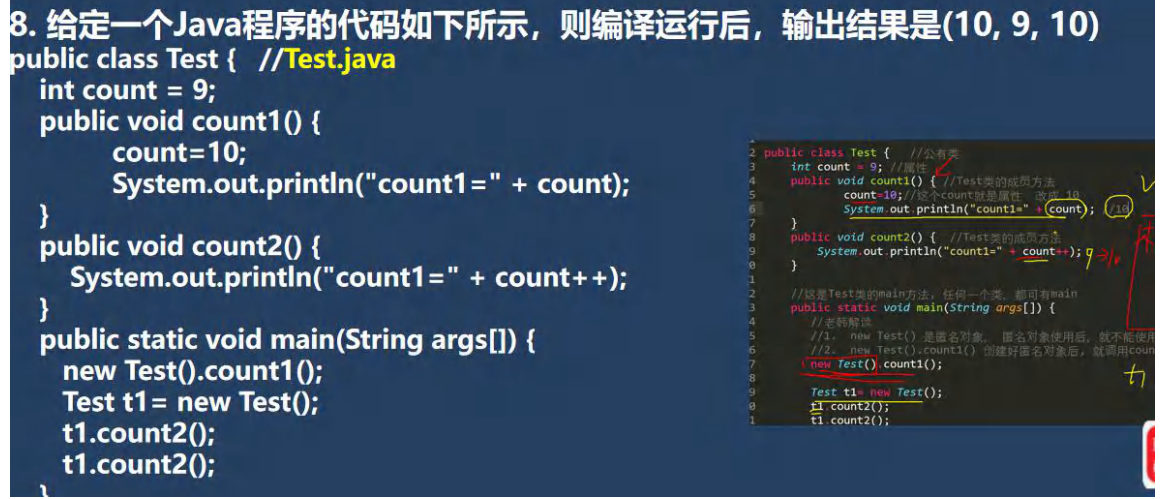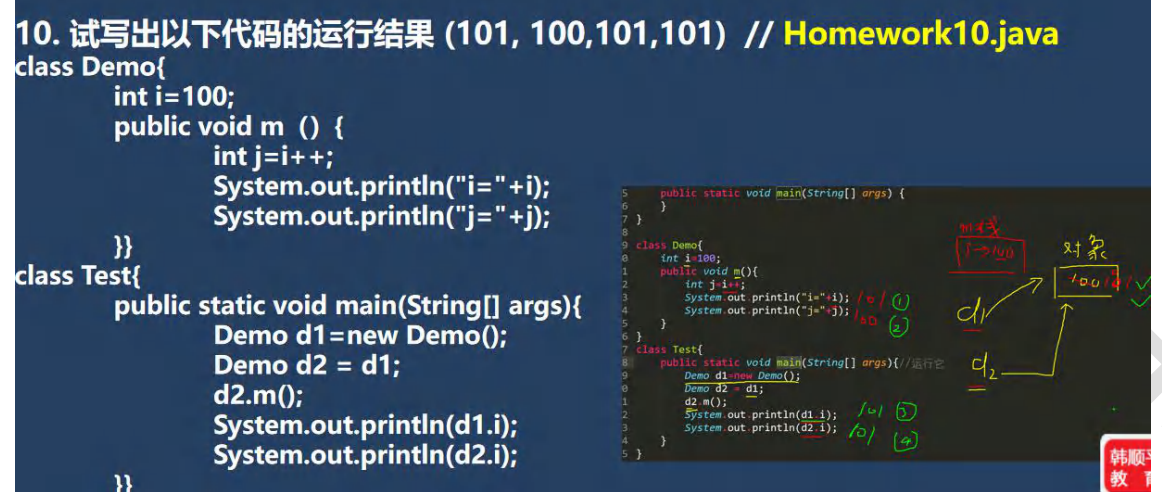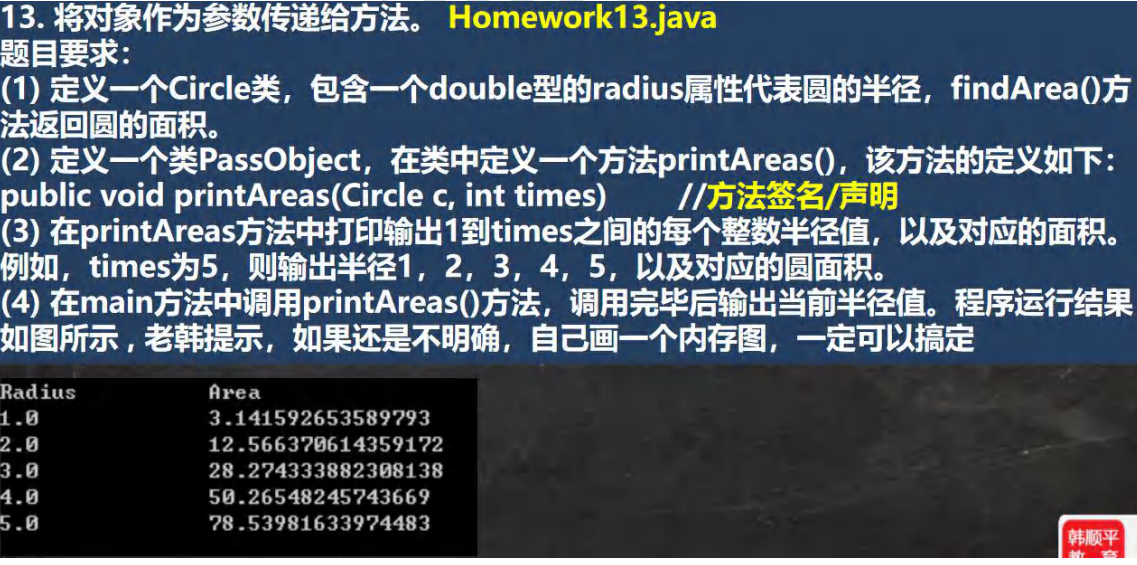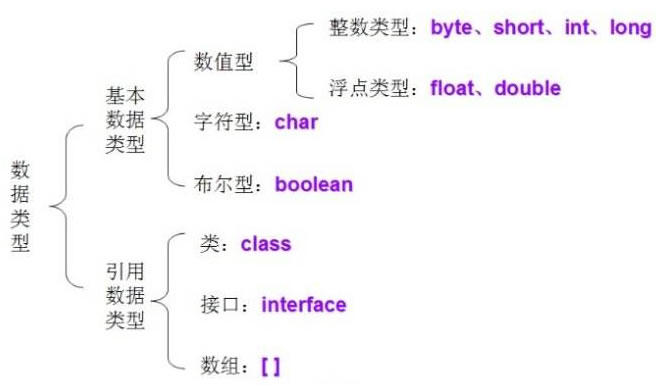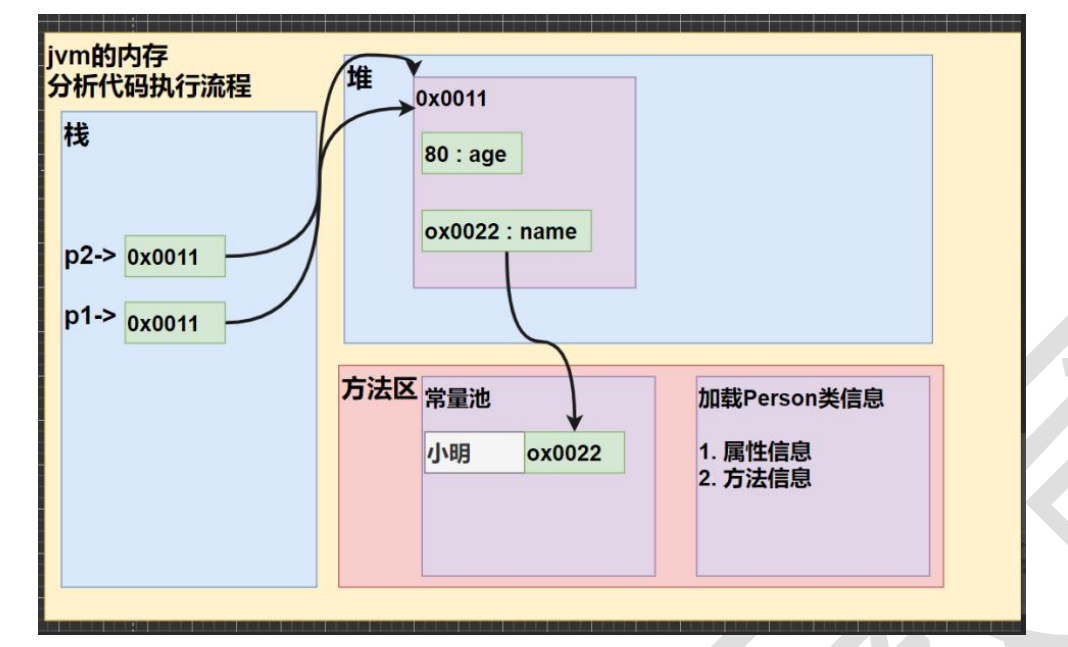本文最后更新于 2024-05-18,文中内容可能已过时。
Java面向对象基础(初级)
对面向对象和面向过程的理解
谈谈你对面向过程和面向对象的理解_智十七°的博客-CSDN博客_面向对象和面向过程的理解
面向对象的三大特征
封装 (Encapsulation)
继承 (Inheritance)
多态 (Polymorphism)
初识对象和类
初次使用对象和类
如下,在下面这个代码中,我创建了一个猫类,然后利用猫类创建了两个猫对象,一个赋值给cat01,一个赋值给cat02
1
2
3
4
5
6
7
8
9
10
11
12
13
14
15
16
17
18
19
20
21
22
23
24
25
26
27
28
29
30
31
32
package cn.meowrain.Object_ ;
public class relean_01 {
public static void main ( String [] args ) {
//创建两猫对象
Cat cat01 = new Cat ();
cat01 . name = "小花" ;
cat01 . age = 1 ;
cat01 . color = "花色" ;
Cat cat02 = new Cat ();
cat02 . name = "小白" ;
cat02 . age = 2 ;
cat02 . color = "白色" ;
//访问对象属性
System . out . println ( cat01 . name );
System . out . println ( cat02 . name );
cat01 . eat ();
cat02 . eat ();
}
}
class Cat {
public String name ;
public int age ;
public String color ;
public void eat (){
System . out . println ( name + "吃饭" );
}
public void drink (){
System . out . println ( name + "喝水" );
}
}
new Cat() //创建一只猫对象
Cat cat01 = new Cat(); //把创建的猫对象赋值给cat01
cat01是对象名(对象引用)
如何创建一个对象
1
2
3
4
5
1 ) 先声明再创建
Cat cat ; //声明对象 cat
cat = new Cat (); //创建
2 ) 直接创建
Cat cat = new Cat ();
补充:Java中实例化对象是什么意思
在Java语言中使用new关键字创建/构造对象的过程叫做类的实例化 ,该过程的本质,会在内存 空间的堆区申请一块存储区域 ,用于记录该对象独有的成员变量信息 。
通俗点就是,实例化:使用关键字new来创建对象。
例如:
Person person = new Person();
这样的语句称为创建对象。
对象是根据类创建的。在Java中使用关键字new创建对象。
new Person(); 是 声明一个Person类型的对象,在堆区区域。
new Person(); ()是指创建Person类型的对象后,自动调用Person类中的构造方法,来进行成员变量的初始化。
Person person ,Person为类名,person 为引用变量名。
————————————————
版权声明:本文为CSDN博主「智十七°」的原创文章,遵循CC 4.0 BY-SA版权协议,转载请附上原文出处链接及本声明。
原文链接:https://blog.csdn.net/weixin_45812336/article/details/113954823
对象在内存中的存在形式
属性,成员变量
1
2
3
4
5
6
7
8
9
10
11
package cn.meowrain.Object_ ;
public class relearn_02 {
}
class Hunman {
//下面都属于Human类的属性
String name ;
double salary ;
int age ;
String country ;
}
属性是类的一个组成部分,一般是基本数据类型,也可是引用类型(对象,数组)。上面这个代码中的name,salary等都是这个Human类的属性
属性的定义语法同变量,
示例:访问修饰符 属性类型 属性名
访问修饰符详情见Java 访问修饰符 - 喵雨の小屋|木更老婆!!! (meowrain.cn)
属性的定义类型可以为任意类型,包含基本类型或引用类型
基本数据类型和引用数据类型详见Java数据类型:基本数据类型和引用数据类型 (biancheng.net)
Java数据类型(八种基本数据类型 + 四种引用数据类型)_火火笔记的博客-CSDN博客_引用数据类型有哪几种
属性如果不赋值,有默认值,规则和数组一致。
具体: ==int 0,short 0, byte 0, long 0, float 0.0,double 0.0,char \u0000, boolean false,String null ==
如何访问属性
基本语法
对象名.属性名;
示范:
1
2
3
4
5
6
7
8
9
10
11
12
13
14
15
package cn.meowrain.Object_ ;
public class relearn_02 {
Human human01 = new Human ();
human01 . name = "mike" ;
human01 . age = 20 ;
System . out . println ( human . name + "is" + human01 . age + "years old" )
}
class Hunman {
//下面都属于Human类的属性
String name ;
double salary ;
int age ;
String country ;
}
类和对象的内存分配机制
我们定义一个人类(Person)(包括 名字,年龄)
1
2
3
4
5
6
7
8
9
10
11
12
13
14
15
16
17
package cn.meowrain.Object_ ;
public class relearn_03 {
public static void main ( String [] args ) {
Person p1 = new Person ();
p1 . age = 10 ;
p1 . name = "小明" ;
Person p2 = p1 ;
System . out . println ( p2 . age );
}
}
class Person {
public int age ;
public String name ;
}
问题:p2.age 究竟是多少,画出内存图
Java 内存的结构分析
栈: 一般存放基本数据类型(局部变量) 堆: 存放对象(Cat cat , 数组等) 方法区:常量池(常量,比如字符串), 类加载信息
Java 创建对象的流程简单分析
方法重载
java中允许同一个类中,多个同名方法的存在,但是要求形参列表不一致
通过重载,我们减轻了起名的麻烦
案例:
1
2
3
4
5
6
7
8
9
10
11
12
13
14
15
16
17
18
19
package cn.meowrain.Object_ ;
public class relearn_06 {
public static void main ( String [] args ) {
rel rel = new rel ();
int m = rel . getSum ( 1 , 2 , 3 );
System . out . println ( m );
int n = rel . getSum ( 1 , 2 );
}
}
class rel {
public int getSum ( int n1 , int n2 ){
return n1 + n2 ;
}
public int getSum ( int n1 , int n2 , int n3 ){
return n1 + n2 + n3 ;
}
}
可变参数
java允许把同一个类中多个同名同功能但是参数个数不同的方法,封装成一个方法
基本语法:
//int... 表示接受的是可变参数,类型是int,即可以接收多个int
//使用可变参数时候,可以当数组来使用,nums可以当做数组
1
2
3
4
5
6
7
8
9
10
11
12
13
14
15
16
17
18
19
20
21
22
23
24
25
package cn.meowrain.Object_ ;
public class relearn_07 {
public static void main ( String [] args ) {
rel_07 rel = new rel_07 ();
int m = rel . getSum ( 1 , 2 , 3 , 4 ); //10
int n = rel . getSum ( 5 , 6 , 7 ); //18
int b = rel . getSum ( 0 , 1 ); //1
System . out . println ( m );
System . out . println ( n );
System . out . println ( b );
}
}
class rel_07 {
//int... 表示接受的是可变参数,类型是int,即可以接收多个int
//使用可变参数时候,可以当数组来使用,nums可以当做数组
public int getSum ( int ... nums ){
int res = 0 ;
for ( int i = 0 ; i < nums . length ; i ++ ){
res += nums [ i ] ;
}
return res ;
}
}
作用域
1
2
3
4
5
6
7
8
9
10
11
12
13
14
15
16
17
18
19
20
21
22
23
24
25
26
27
28
29
30
31
32
33
34
35
36
37
package cn.meowrain.Object_ ;
public class relearn_08 {
public static void main ( String [] args ) {
}
}
class Dog {
//全局变量:也就是属性,作用域为整个类体Cat类,cry eat等方法使用属性
//属性在定义时,可以直接赋值
int age = 10 ;
double weight ; //默认是0.0
public void hi () {
//局部变量必须赋值后才能使用,因为没有默认值
//局部变量一般是指在成员方法中定义的变量
int num = 1 ;
String address = "Beijing's Dog" ;
System . out . println ( "num=" + num );
System . out . println ( "address" + address );
System . out . println ( "weight=" + weight );
}
public void cry () {
int n = 10 ;
String name = "jack" ;
System . out . println ( name + "cry for" + n + "times" );
}
public void eat () {
String name = "meow" ;
System . out . println ( name + "eat" );
}
}
注意事项和使用细节
属性可以加修饰符,但是局部变量不能加修饰符
构造器
构造方法又叫构造器(constructor),是类的一种特殊的方法,
它的主要作用是完成对新对象的初始化。它有几个特点:
方法名和类名相同
没有返回值
在创建对象时,系统会自动的调用该类的构造器完成对象的初始化。
基本语法:
1
2
3
[ 修饰符 ] 方法名 ( 形参列表 ) {
方法体
}
案例:
1
2
3
4
5
6
7
8
9
10
11
12
13
14
15
16
17
18
19
20
21
22
23
24
25
26
27
28
29
30
31
32
33
34
35
36
37
package cn.meowrain.Object_ ;
public class relearn_09 {
public static void main ( String [] args ) {
rel_09 rel = new rel_09 ( "meowrain" , 18 );
rel_09 rel_1 = new rel_09 ( "meow" , 20 , "mouse" );
rel . getInfo ();
rel_1 . getItem ();
}
}
class rel_09 {
String name ;
int age ;
String item ;
public rel_09 ( String name , int age ) {
this . name = name ;
this . age = age ;
}
// 构造器重载
public rel_09 ( String name , int age , String item ) {
this . name = name ;
this . age = age ;
this . item = item ;
}
public void getInfo () {
System . out . println ( this . name + " " + this . age );
}
public void getItem () {
System . out . println ( this . item );
}
}
练习题:
1
2
3
4
5
6
7
8
9
10
11
12
13
14
15
16
17
18
19
20
21
22
23
24
25
26
package cn.meowrain.Object_ ;
public class relearn_10 {
public static void main ( String [] args ) {
Person_n person01 = new Person_n ( "meow" , 12 );
Person_n person02 = new Person_n ();
System . out . println ( person01 . name + " is " + person01 . age + "years old" );
System . out . println ( person02 . name + " is " + person02 . age + "years old" );
}
}
class Person_n {
String name ;
int age ;
public Person_n () {
this . age = 18 ;
}
public Person_n ( String name , int age ) {
this . name = name ;
this . age = age ;
}
}
对象创建的流程分析
this关键字
什么是this?
==简单说:哪个对象调用,this就代表哪个对象==
1
2
3
4
5
6
7
8
9
10
11
12
13
14
15
16
17
18
19
20
21
22
23
package cn.meowrain.Object_ ;
public class relearn12 {
}
class This01 {
public static void main ( String [] args ) {
Dog_new dog_new = new Dog_new ( "大黄" , 1 );
dog_new . info ();
}
}
class Dog_new {
String name ;
int age ;
public Dog_new ( String name , int age ) {
this . name = name ;
this . age = age ;
}
public void info (){
System . out . println ( "this.hashCode=" + this . hashCode ());
System . out . println ( name + "\t" + age + "\t" );
}
}
练习题:
1
2
3
4
5
6
7
8
9
10
11
12
13
14
15
16
17
18
19
20
21
22
23
24
package cn.meowrain.Object_ ;
public class relearn13 {
public static void main ( String [] args ) {
person_01 p1 = new person_01 ( "mary" , 18 );
person_01 p2 = new person_01 ( "mary" , 18 );
System . out . println ( p1 . compareTo ( p2 )); //true
}
}
class person_01 {
String name ;
int age ;
public person_01 ( String name , int age ) {
this . name = name ;
this . age = age ;
}
public boolean compareTo ( person_01 p ){
if ( this . name . equals ( p . name ) && this . age == p . age ) {
return true ;
}
return false ;
}
}
作业
作业1
1
2
3
4
5
6
7
8
9
10
11
12
13
14
15
16
17
18
19
20
21
22
package cn.meowrain.Object_.homework ;
public class h1 {
public static void main ( String [] args ) {
double [] arr = { 1 . 0 , - 2 . 0 , 4 . 5 };
A01 a01 = new A01 ();
double max = a01 . max ( arr );
System . out . println ( max );
}
}
class A01 {
public double max ( double [] a ) {
double m = a [ 0 ] ;
for ( int i = 0 ; i < a . length ; i ++ ) {
if ( a [ i ] > m )
m = a [ i ] ;
}
return m ;
}
}
作业2
1
2
3
4
5
6
7
8
9
10
11
12
13
14
15
16
17
18
19
20
21
22
23
24
25
package cn.meowrain.Object_.homework ;
public class h2 {
public static void main ( String [] args ) {
String [] strArr = { "helloworld" , "meowrain" };
A02 a02 = new A02 ();
int a = a02 . find ( strArr );
if ( a == 0 ){
System . out . println ( true );
} else {
System . out . println ( false );
}
}
}
class A02 {
public int find ( String [] arr ){
for ( int i = 0 ; i < arr . length ; i ++ ){
if ( arr [ i ] . equals ( "helloworld" )){
return i ;
}
}
return - 1 ;
}
}
作业3
1
2
3
4
5
6
7
8
9
10
11
12
13
14
15
16
17
18
19
20
21
22
23
24
25
26
27
28
29
30
31
32
33
34
35
36
package cn.meowrain.Object_.homework ;
public class h3 {
public static void main ( String [] args ) {
Book book = new Book ( "猫的故事" , 200 );
Book book2 = new Book ( "狗的故事" , 120 );
Book book3 = new Book ( "驴的故事" , 20 );
book . updatePrice ( book . price );
book2 . updatePrice ( book2 . price );
book3 . updatePrice ( book3 . price );
System . out . println ( book . name + " : " + book . price );
System . out . println ( book2 . name + " : " + book2 . price );
System . out . println ( book3 . name + " : " + book3 . price );
/*
* 猫的故事 : 150.0
狗的故事 : 100.0
驴的故事 : 20.0
*
*/
}
}
class Book {
String name ;
double price ;
public Book ( String name , double price ) {
this . name = name ;
this . price = price ;
}
public void updatePrice ( double price ){
if ( price > 150 ){
this . price = 150 ;
} else if ( price > 100 ) {
this . price = 100 ;
}
}
}
作业4
1
2
3
4
5
6
7
8
9
10
11
12
13
14
15
16
17
18
19
20
21
22
package cn.meowrain.Object_.homework ;
public class h4 {
public static void main ( String [] args ) {
A03 a03 = new A03 ();
int [] arr = { 1 , 2 , 3 , 4 , 5 };
int [] a1 = a03 . copyArr ( arr );
for ( int i = 0 ; i < a1 . length ; i ++ ){
System . out . println ( a1 [ i ] );
}
}
}
class A03 {
public int [] copyArr ( int [] arr ) {
int [] a = new int [ arr . length ] ;
for ( int i = 0 ; i < arr . length ; i ++ ){
a [ i ] = arr [ i ] ;
}
return a ;
}
}
作业5
1
2
3
4
5
6
7
8
9
10
11
12
13
14
15
16
17
18
19
20
21
22
23
24
25
26
27
28
29
30
package cn.meowrain.Object_.homework ;
public class h5 {
public static void main ( String [] args ) {
Circle circle = new Circle ( 2 );
double perimeter = circle . perimeter ();
double area = circle . area ();
System . out . printf ( "%.2f\n" , perimeter );
System . out . printf ( "%.2f\n" , area );
/*
* 12.57
12.57
*/
}
}
class Circle {
double r ;
public Circle ( double r ) {
this . r = r ;
}
public double perimeter () {
return Math . PI * r * 2 ;
}
public double area () {
return Math . PI * r * r ;
}
}
作业6
1
2
3
4
5
6
7
8
9
10
11
12
13
14
15
16
17
18
19
20
21
22
23
24
25
26
27
28
29
30
31
32
33
34
35
36
37
package cn.meowrain.Object_.homework ;
public class h6 {
public static void main ( String [] args ) {
Cale cale01 = new Cale ( 5 , 2 );
Cale cale02 = new Cale ( 1 , 0 );
cale01 . divide ();
cale02 . divide ();
}
}
class Cale {
int a , b ;
public Cale ( int a , int b ) {
this . a = a ;
this . b = b ;
}
public int sum () {
return a + b ;
}
public int multiply () {
return a * b ;
}
public void divide () {
if ( b == 0 ) {
System . out . println ( "输入的除数不能为0!" );
} else {
System . out . println ( a * 1 . 0 / b );
}
}
}
作业7
1
2
3
4
5
6
7
8
9
10
11
12
13
14
15
16
17
18
19
20
21
package cn.meowrain.Object_.homework ;
public class h7 {
public static void main ( String [] args ) {
Dog dog = new Dog ( "mike" , "white" , 2 );
dog . show ();
}
}
class Dog {
String name ;
String color ;
int age ;
public Dog ( String name , String color , int age ){
this . name = name ;
this . color = color ;
this . age = age ;
}
public void show (){
System . out . println ( "the dog " + name + " is " + age + " " + "years old and its color is " + color );
}
}
作业8
作业9
1
2
3
4
5
6
7
8
9
10
11
12
13
14
15
16
17
18
19
20
21
22
23
24
25
26
27
package cn.meowrain.Object_.homework ;
public class h9 {
public static void main ( String [] args ) {
Music music01 = new Music ( "青花瓷" , "4:00" );
Music music02 = new Music ( "鸡你太美" , "3:00" );
music01 . getInfo ();
music01 . play ();
}
}
class Music
{
String name ;
String times ;
public Music ( String name , String times ){
this . name = name ;
this . times = times ;
}
public void play (){
System . out . println ( name + "is palying for " + times );
}
public void getInfo (){
System . out . println ( "the music name is " + name + "times is : " + times );
}
}
作业10
1
2
3
4
5
6
7
8
9
10
11
12
13
14
15
16
17
18
19
20
package cn.meowrain.Object_.homework ;
public class h8 {
int i = 100 ;
public void m (){
int j = i ++ ;
System . out . println ( "i=" + i );
System . out . println ( "j=" + j );
}
}
class Test {
public static void main ( String [] args ) {
h8 demo = new h8 ();
h8 demo2 = new h8 ();
demo . m ();
System . out . println ( demo . i );
System . out . println ( demo2 . i );
}
}
1
2
3
4
i = 101
j = 100
101
100
作业11
作业12
1
2
3
4
5
6
7
8
9
10
11
12
13
14
15
16
17
18
19
20
21
22
23
24
25
26
27
28
29
30
31
32
33
package cn.meowrain.Object_.homework ;
public class h12 {
Employee_ emp1 = new Employee_ ( "经理" , "10000" );
}
class Employee_ {
String name ;
String sex ;
int age ;
String position ;
String salary ;
public Employee_ ( String name , String sex , int age , String position , String salary ) {
this . name = name ;
this . sex = sex ;
this . age = age ;
this . position = position ;
this . salary = salary ;
}
public Employee_ ( String name , String sex , int age ) {
this . name = name ;
this . sex = sex ;
this . age = age ;
}
public Employee_ ( String position , String salary ) {
this . position = position ;
this . salary = salary ;
}
}
作业13
1
2
3
4
5
6
7
8
9
10
11
12
13
14
15
16
17
18
19
20
21
22
23
24
package cn.meowrain.Object_.homework ;
public class h13 {
public static void main ( String [] args ) {
Circle01 circle = new Circle01 ();
PassObject pass = new PassObject ();
pass . printAreas ( circle , 5 );
}
}
class Circle01 {
public double radius ;
public double findArea (){
return radius * radius * Math . PI ;
}
}
class PassObject {
public void printAreas ( Circle01 c , int times ) {
for ( int i = times ; i > 0 ; i -- ){
c . radius = i ;
System . out . println ( "r:" + i + " " + "S=" + c . findArea ());
}
}
}


